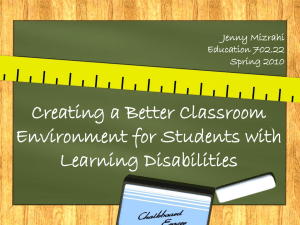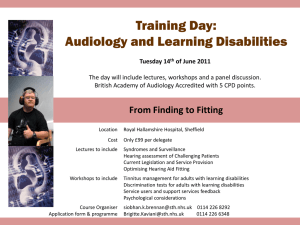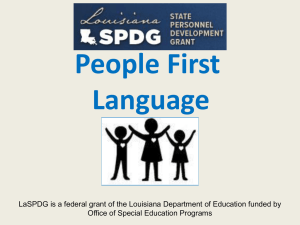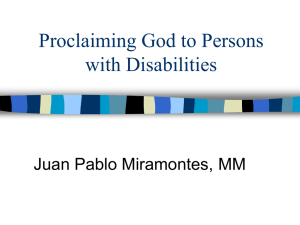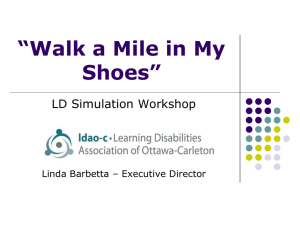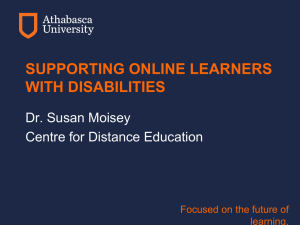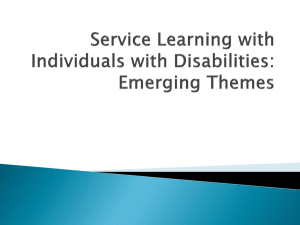JennyMizEduc702finalppt
advertisement
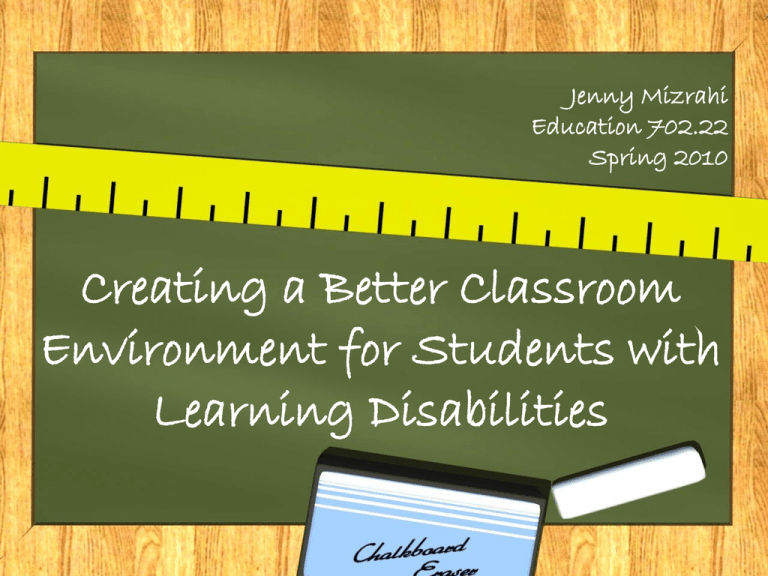
Jenny Mizrahi Education 702.22 Spring 2010 Creating a Better Classroom Environment for Students with Learning Disabilities Introduction Statement of the Problem Literature Review Statement of Hypothesis Methods – Participants & Instruments References Appendices Statement of the Problem When considering the fact that not all children learn the same way and at the same pace, teachers need to find a good teaching method for their class in which include students with learning disabilities. Educators today are trying to find successful ways to teach students with learning disabilities. But is there a “best” approach when teaching learning disabled students? Literature Review Creating a comfortable and positive classroom environment for LD students (Berry, 2006; Westby, 1997; Klotz 2004; Regan, 2009; Wormeli, 2003; Bergin & Bergin, 2009) Improving teachers’ and students’ perceptions about LD students in the mainstream classroom (Klotz, 2004; Bear, Minke, Griffin, & Deemer, 1998; Begeny, Eckert, Montarello, & Storie, 2008) Literature Review (con’t) Changing LD students’ perceptions about themselves and their academic achievement (Myles & Simpson, 2001; Beltempo & Achille, 1990; Kern, Hilt-Panahon, & Sokol, 2009) Theorist and practitioner who affected education system today – John Dewey (Westbrook, 1993) – Maria Montessori (Brehony, 2000) Literature Review (con’t) Integrating technology in the classroom and at home (Berninger, Abbott, Augsburger, & Garcia, 2009; Jeffs, Behrmann, & Bannan-Ritland, 2006; Miller, Fitzgerald, Koury, Mitchem, & Hollingsead, 2007; van Daal, & van der Leij, 1992; Smith, n.d.; Frengut, 2004) Assistive Technology tools (Jeffs, et. al., 2006) KidTools (Miller, et. al., 2007) Literature Review (con’t) Integrating the use of different verbal communications between peers and teachers (Berry, 2006; Charlton, Williams, & McLaughlin, 2005; Cihak, Kirk, & Boon, 2009; Kugelmass, 1995; Scala, 1993) Whole-Class Lessons (Berry, 2006) Educational Games: i.e. word puzzles, card games, board games (Charlton, 2005) Literature Review (con’t) Positive Peer “Tootling”: students tattletale positive behaviors of their peers instead of reporting on negative behaviors (Cihak, et. al., 2009) Foxfire approach (Kugelmass, 1995) Statement of Hypothesis HR1: Using technology (i.e. computers, internet, etc.) in a third-grade classroom of 16 LD and EBD students at P.S. X in Brooklyn, NY over a five-week period, twice a week for 30 minutes a day will improve their literacy skills. Method Participants (N): 16 third-graders at P.S. X in Brooklyn, NY will participate in this study. The participants will include eight boys and eight girls. The chosen students should have a learning disability and/or an emotional and/or behavioral disorder in order to be a part of this study. Method (con’t) Instruments: First, consent forms will be sent to the principal and parents/guardian. To test the effectiveness of technology in the classroom, demographic surveys will be given out on day one of the study to see how comfortable the students are using technology in school. Questionnaires will be given out at the end of the study to see how effective the use of technology has been for them in the past five weeks. References Bear, G. G., Minke, K. M., Griffins, S. M., & Deemer, S. A. (1998). Achievement-Related Perceptions of Children with Learning Disabilities and Normal Achievement: Group and Developmental Differences. Journal of Learning Disabilities, 31(1), 91-104. Begeny, J. C., Eckert, T. L., Montarello, S. A., & Storie, M. S. (2008). Teachers’ Perceptions of Students’ Reading Abilities: An Examination of the Relationship Between Teachers’ Judgments and Students’ Performance Across a Continuum of Rating Methods. School Psychology Quarterly, 23(1), 43-55. Beltempo, J., & Achille, P. A. (1990). The Effect of Special Class Placement on the Self-Concept of Children with Learning Disabilities. Child Study Journal, 20(2), 81-103. Bergin, C., & Bergin, D. (2009, June 30). Relationships Improve Student Success. Education Psychology Review. Retrieved from http://www.sciencedaily.com/releases/2009/06/090630132009.htm References (con’t) Berninger, V. W., Abbott, R. D., Augsburger, A., Garcia, N. (2009). Comparison of Pen and Keyboard Transcription Modes in Children With and Without Learning Disabilities. Learning Disability Quarterly, 32(3), 123-141. Berry, R. A. W. (2006). Teacher Talk During Whole-Class Lessons: Engagement Strategies to Support the Verbal Participation of Students with Learning Disabilities. Learning Disabilities Research and Practice, 21(4), 211-232. Brehony, K. J. (2000). Montessori, Individual Work and Individuality in the Elementary School Classroom. History of Education, 29(2), 115-128. Charlton, B, Williams, R. L., McLaughlin, T. F. (2005). Educational Games: A Technique to Accelerate the Acquisition of Reading Skills of Children with Learning Disabilities. International Journal of Special Education, 20(2), 66-72. References (con’t) Cihak, D. F., Kirk, E. R., Boon, R. T. (2009). Effects of Classwide Positive Peer “Tootling” to Reduce Disruptive Classroom Behaviors of Elementary Students with and without Disabilities. Journal of Behavioral Education, 18(4), 267-278. Frengut, R. (2003). Social Acceptance of Students with Learning Disabilities. Retrieved from http://ldaamerica.org/aboutld/teachers/social_emotional/socialacceptance.asp Jeffs, T., Behrmann, M., Bannan-Ritland, B. (2006). Assistive Technology and Literacy Learning: Reflections of Parents and Children. Journal of Special Education Technology, 21(1), 37-44. Kaderavek, J. N., & Justice, L. (2000). Children with LD as Emergent Readers: Bridging the Gap to Conventional Reading. Intervention in School and Clinic, 36(2), 82-93. References (con’t) Kern, L., Hilt-Panahon, A., & Sokol, N. G. (2009). Further Examining the Triangle Tip: Improving Support for Students with Emotional and Behavioral Needs. Psychology in the Schools, 46(1), 18-32. Klotz, M. B. (2004, February). Help Kids Welcome Disabled Students. The Education Digest, 69(6), 41-42. Kugelmass, J. W. (1995). Educating Children with Learning Disabilities in Foxfire Classrooms. Journal of Learning Disabilities, 28(9), 545-553. Miller, K. J., Fitzgerald, G. E., Koury, K. A., Mitchem, H. J., Hollingsead, C. (2007). KidTools: Self-Management, Problem-Solving, Organizational, and Planning Software for Children and Teachers. Intervention in School and Clinic, 43(1), 12-19. References (con’t) Myles, B. S., & Simpson, R. L. (1990). Mainstreaming Modification Preferences of Parents of Elementary-Age Children with Learning Disabilities. Journal of Learning Disabilities, 23(4), 234-239. Regan, K. S. (2009). Improving The Way We Think About Students With Emotional and/or Behavioral Disorders. Teaching Exceptional Children, 41(5), 60-65. Sanacore, J. (1999). Encouraging Children to Make Choices About Their Literacy Learning. Intervention in School and Clinic, 35(1), 38-42. Scala, M. A. (1993). What Whole Language in the Mainstream Means for Children with Learning Disabilities. Reading Teacher, 47(3), 222-229. Smith, M. (n.d.) Strategies That Work. Retrieved from http://www2.scholastic.com/browse/article.jsp?id=60&print=1 References (con’t) van Daal, V. H. P., van der Leij, A. (1992). Computer-Based Reading and Spelling Practice for Children with Learning Disabilities. Journal of Learning Disabilities, 25(3), 186-195. Westbrook, R. B. (1993). John Dewey. Prospects: The Quarterly Review of Comparative Education, 23(1/2), 277-291. Westby, C. (1997). There’s More To Passing than Knowing the Answers. Language, Speech, and Hearing Services in School, 28(3), 274-287. Wormeli, R. (2003). Differentiating Instruction: A Modified Concerto in Four Movements. Retrieved from http://www.ldonline.org/article/Differentiating_Instruction:_A_Modified_Concerto_in_ Four_Movements Appendices Appendix A: Consent Forms written out to the principal and parents/guardian explaining me being there, why I’m there, my action research project (my HR1), and asking for permission to (1) conduct the study in the school, and (2) asking permission for the parents/guardian’s child to participate in the study. Appendix B: Demographic Survey asking students how often they use the computer, if they have access at home and/or at school, and how many times a week they access the computer Appendices (con’t) Appendix C: Questionnaire asking students on the last day of the study to rate the questions asked on a 1-5 rating scale where “1”=disagree and “5”=strongly agree. I, the researcher, want to find out how much they learned over the last five weeks, if they enjoyed using the computer, how comfortable they now feel using a computer, etc.
